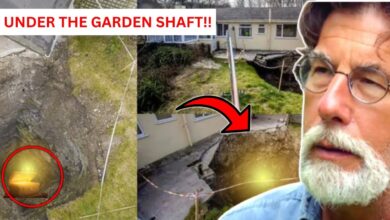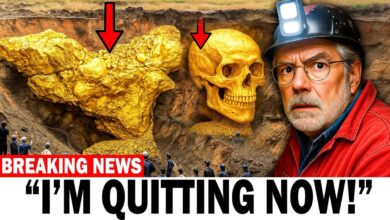The Curse of Oak Island: Silver Treasure Discovered in the Money Pit (Season 12)
The Curse of Oak Island: Silver Treasure Discovered in the Money Pit (Season 12)

GARY: No mistaking
these spoils, mate.
Now, all of these spoils
that we’re gonna go over today,
came from Lot 5
around the big feature.
There’s a big pile…
NARRATOR:
Metal detection expert
Gary Drayton
and Peter Fornetti
arrive on Lot 4,
located on the western side
of the island.
-Now, let’s get stuck
in there, mate.
-Okay.
NARRATOR:
They are searching
more than ten tons of spoils
that were excavated last year
from the mysterious
round feature
near the shoreline of Lot 5.
Since the team
has found artifacts
in that stone-lined foundation
that wildly vary in age–
such as the 14th-century
lead barter token
and 17th-century iron tools–
and also, because
they have recovered
a mortar-like substance
within it that matches materials
discovered more than 100 feet
deep in the Money Pit,
as well as below Cone E
of the potentially
800-year-old Nolan’s Cross…
We’ll go over it twice, Pete.
-PETER: Sounds good.
-Nonferrous first.
And then we’ll pull
some ferrous out.
NARRATOR:
…Rick and Marty are hoping
that Gary and Peter
will find more clues
to help confirm
when the feature was created,
and, most importantly, why.
(metal detector beeping)
-Ooh, a banging signal, mate.
-Okay.
It’s gonna be good, mate.
Just there.
Let’s do it.
(metal detector beeping)
-It’s out.
-Ooh, it’s out.
Let’s see what we’ve got.
(pinpointer beeping)
PETER:
In your hand?
GARY:
What a find!
-I think we’ve found a cut coin.
-Okay.
GARY:
And if this is
a cut coin, mate…
(stammers) Oh…
-I’m getting…
-(chuckling)
-I’m getting bumswizzled, mate.
-Yeah.
If this is a cut coin, mate,
-it could well be
a Spanish coin.
-Mm-hmm.
-More than likely,
it’s silver, mate.
-Okay.
GARY:
And that has got to be
a really clean break
to cut in like
a quarter like that.
‘Cause that’s what
they used to do.
-They used to cut
the silver and gold coins up.
-Okay.
-It was to make change
back in the day.
-Mm-hmm.
NARRATOR: A cut–
potentially Spanish–
treasure coin?
Between the 15th
and 18th centuries,
when European nations
such as Spain,
England and France
were colonizing
and establishing trade routes
throughout the Americas,
it was common practice
for both militaries
and outlaw pirates to cut coins
and distribute them
as payment to crew members.
This can tell a story,
-and I know that
my Uncle Rick…
-Yeah.
…is going to be really excited
to see this.
-He is, mate.
-(laughs)
-High five, mate.
-All right.
This is absolutely brilliant.
We’ll put it in a bag, mate,
and let’s get it
back to the lab.
All right. Let’s do it.
-What a day.
-GARY: Wow. What a day,
all right.
NARRATOR:
Following their discovery
on Lot 4…
RICK:
Well, well, well…
-(sighs)
-(laughs)
-Look at that walk. (laughs)
-What a strut.
NARRATOR:
…Gary and Peter arrive
at the Oak Island Laboratory
to share it with Rick
and Jack Begley
and have it analyzed
by archaeologist Laird Niven
and archaeometallurgist
Emma Culligan.
-What’s up?
-GARY: Well, Pete and I
-What’s up?
-GARY: Well, Pete and I
have been searching
those spoils off Lot 5,
and we have just recovered
a real top-pocket find.
You are gonna love this.
Ooh…
What do you think
of that beauty?
It’s got some weight to it.
What is it?
LAIRD:
It’s a cut coin.
GARY:
And Pete and I believe
it’s more than likely
gonna be silver.
-No way!
-Way!
-And it’s perfectly cut.
-GARY: Yeah.
-It’s quartered, right?
-Yeah.
This is treasure.
This is Oak Island treasure.
I’m gonna pop it out,
put it in the CT scan,
and try to get an image.
LAIRD:
Let’s do it.
NARRATOR:
In order to visualize
any identifiable features
on the coin,
Emma will now analyze it
with the
Skyscan 1273 CT scanner.
The device works
by emitting X-ray radiation
to produce magnified,
three-dimensional images
of artifacts.
This is a really,
really quick scan.
So, it’s not gonna be
a great image.
There is a lot of scratch marks.
A longer scan should reveal
a lot more detail.
RICK:
So, you’re gonna run
a longer scan?
Mm-hmm. Oh, yeah.
We’re gonna have to be
a bit more patient.
-Mm-hmm.
-It’s early days.
-It’s early days.
-RICK: Where there’s one,
there might be two,
three, four, five.
GARY:
Oh, yeah.
Yeah, because
this was cut up as change.
RICK:
So, look, a great day.
You guys did your high five
out in the field.
-LAIRD: Yeah, yeah.
-We’ll do a high five
in here, all right?
Come on.
GARY:
Uh… Uh.
RICK:
There’s only one thing to say.
Let’s go find more.
RICK: Lady, gentlemen,
today we’re gonna learn
about something
that I think has caused
great excitement.
NARRATOR:
Rick and other members
of the team meet
via video conference
with Marty and Craig
in the war room.
They are eager to hear
an updated scientific report
on the silver coin
that was discovered
in the spoils removed
from the stone foundation
on Lot 5.
Hopefully, Emma can
tell us what she found out
about this cut coin.
So, the CT scanner,
although it could catch
some of the abraded surface,
like all the scratches
on the surface,
getting any detail was
nearly impossible.
We couldn’t really see
any details,
but there was faint signs
or faint engravings on one side.
LAIRD:
You could see
some sort of writing on it,
-but couldn’t make it out.
-Mm.
So I just popped
that into the XRF map scanner.
So this is
a compositional surface scan
of one side of that coin.
It is, in fact, silver,
but it does have a little bit
of a lead content.
Like, I only left these elements
’cause they image really well
on the XRF map.
NARRATOR:
X-ray fluorescence–
or XRF scanning–
uses highly-focused beams
of x-rays,
which assigns specific colors
to the elements
that are present
on the surface of objects.
The process reveals fine,
microscopic details
that are not visible
to the naked eye.
Initially,
when you guys brought it in,
we did think
that it could be Spanish.
But as you can see,
you see the “GVLI”
-really clearly.
-GARY: Hmm.
EMMA:
And this little…
little design over here…
…and these two
little triangular spots.
ALEX:
Mm-hmm.
So, this right here
is a William III shilling.
Silver, same diameter.
And it matches
the designs to a T.
-MARTY: Wow.
-ALEX: Wow.
EMMA:
So it’s an English shilling
from the 1690s.
Oh, yeah.
You can see the ponytail.
EMMA:
Yeah.
And the little two triangles
is its little ribbon.
Wow, that’s a shocker.
Emma, fantastic detective work.
I mean, there’s
a million coins out there,
and to have that match like that
is really, really cool.
Very impressive.
She’s figured out
what coin this is.
-Yep.
-ALEX: Mm-hmm.
Absolutely.
MARTY:
Laird, doesn’t this kind of go
to your thought that
that habitation there on Lot 5,
you know,
was older than mid-1700s,
pushing things back
into the 1600s or very close?
Is that all correct?
Yeah. Yeah.
It certainly supports
a possible earlier date.
So this may also suggest
that this was
a stopping place for them
over a period of time.
Yes.
The hell was they doing there?
MARTY: Well, this is much
less likely to be a component
of treasure, but rather
-somebody who was on Lot 5
doing something– some
-Yup.
-officer, perhaps, being paid.
-Yup.
This makes me think
of a book I read by, uh,
This makes me think
of a book I read by, uh,
Graham Harris and Les MacPhie
about the British military
trying to recover, um,
William Phips’ treasure
here on Oak Island.
NARRATOR:
In their 1999 book
entitled Oak Island
and Its Lost Treasure,
Graham Harris and Les MacPhie
put forth an extraordinary
theory about secret events
that they believe took place
on Oak Island
after Sir William Phips
allegedly buried a treasure
vault in the Money Pit area.
According to their research,
English allies of Phips,
who assisted him
and Andrew Belcher
during the second
treasure salvage operation
of the Concepción,
made a number of failed attempts
to retrieve the valuables
on Oak Island
between the late 1600s
and the 1750s.
DOUG:
So, if-if that’s true,
this could be evidence that
the British military were here.
That fits in really well.
NARRATOR:
Could Doug Crowell be correct
that this 1697 silver
English coin might be connected
to one of those failed
treasure recoveries?
DOUG:
They didn’t retrieve
the treasure.
And the gold
and silver particles
in the current water test
indicate
that that treasure’s
probably still there.
You got to find it, man.
And I think this is
somehow significant.
The things happening on Lot 5
have certainly moved the dial.
I’m sure of that.
Yeah.
RICK:
Oak Island is
a very complex mystery.
Perhaps a mystery
that has been developing
over decades, if not centuries.
But there’s one way
for this to be put to bed.
We have to find proof
that the most hardened skeptic
says, “I believe.”
And we continue
to endeavor to do that.
Okay, I think we’re all set to
get out back and keep digging.
-Okay.
-Okay.
MARTY:
Get back out there
and find some more. (laughs)








